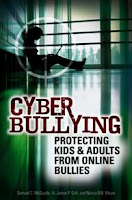There are obviously many pieces to the complex puzzle of bullying, but developing a greater understanding of the issue provides a solid foundation to initiate meaningful and much needed change. Enduring myths about bullying however continue to be accepted as truths by adults as well as youth, who look to the adults for guidance on how to respond in bullying situations. The following myths must be debunked in order for additional progress to be made in reducing bullying behaviors, with the caveat that the “truths” offered below in response to each of the myths are not absolute. In reality bullying is a complex social problem made worse by virtue of capabilities now provided as a result of the Internet and technological devices. No single myth or suggested truth is likely to sum up every bullying situation encountered by youth.
Myth #1: Bullying helps victims “toughen up,” and only makes them stronger in the long run.
Truth: Bullying generally does not help victims toughen up—it causes substantial pain. Left unchecked continued bullying causes more pain.
Myth #2: Bullying is a “normal” part of childhood development. Get over it.
Truth: Being repeatedly subjected to cruel and abusive treatment is not a normal part of childhood development or acceptable in civil societies as a matter of law.
Truth: Being repeatedly subjected to cruel and abusive treatment is not a normal part of childhood development or acceptable in civil societies as a matter of law.
Myth #3: Bullying is sometimes just “playing or goofing around” so what’s the big deal?
Truth: Bullying is not playing around unless everyone involved is having a good time.
Truth: Bullying is not playing around unless everyone involved is having a good time.
Myth #4: When bullying becomes serious enough, kids will tell an adult.
Truth: Youth rarely tell parents or other adults about being bullied. This is especially true if their friends are the bullies. Instead they live by a code of silence with “no snitching” allowed.
Truth: Youth rarely tell parents or other adults about being bullied. This is especially true if their friends are the bullies. Instead they live by a code of silence with “no snitching” allowed.
Myth #5: Parents of students who bully or are bullied, are usually aware of the problem and will intercede if they deem it necessary.
Truth: Because bullying victims rarely tell parents or other adults what is happening in their online world, grownups are often unaware of the warning signs.
Truth: Because bullying victims rarely tell parents or other adults what is happening in their online world, grownups are often unaware of the warning signs.
Myth #6: Most bullying occurs outside of school or on the way to and from school.
Truth: Although schools usually provide for very safe computing environments, most physical and verbal bullying occurs within schools or in connection with school activities. Cyber bullying however, can occur at any time, while a victim is interacting with bullies online or not, and from any location in which portable computing devices make it possible for bullies and/or victims to connect to the Internet.
Truth: Although schools usually provide for very safe computing environments, most physical and verbal bullying occurs within schools or in connection with school activities. Cyber bullying however, can occur at any time, while a victim is interacting with bullies online or not, and from any location in which portable computing devices make it possible for bullies and/or victims to connect to the Internet.
Myth #7: Physical bullying is the most common form of bullying among boys and girls.
Truth: Verbal bullying is the most common form.
Truth: Verbal bullying is the most common form.
Myth #8: Bullies suffer from insecurity and low self-esteem.
Truth: While some bullies are insecure or have low self-esteem, many bullies are not suffering in these ways. For whatever other reason(s) they can be just mean!
Truth: While some bullies are insecure or have low self-esteem, many bullies are not suffering in these ways. For whatever other reason(s) they can be just mean!
Myth #9: Bullying and conflict mean the same thing.
Truth: Bullying involves a perpetrator holding power over and dominating a victim in some way usually over an extended period of time. Conflict however, involves mutual disagreements. Whereas two or more parties involved in conflicts may perceive themselves as being “the victim” who needs to stand up for their rights, bullies originate and perpetuate one-way aggression directed toward the victim(s).
Truth: Bullying involves a perpetrator holding power over and dominating a victim in some way usually over an extended period of time. Conflict however, involves mutual disagreements. Whereas two or more parties involved in conflicts may perceive themselves as being “the victim” who needs to stand up for their rights, bullies originate and perpetuate one-way aggression directed toward the victim(s).
Myth #10: Bullying affects only a small number of students.
Truth: Bullying affects a large number of students as victims or witnesses in direct or indirect ways. Spin-off effects of bullying can disrupt families, school environments, neighborhoods, and even entire communities.
Truth: Bullying affects a large number of students as victims or witnesses in direct or indirect ways. Spin-off effects of bullying can disrupt families, school environments, neighborhoods, and even entire communities.
------------------------------------------------------------------------------------------------------------
Read More...
Read More...
Adapted from Chapter 2: Characteristics and Causes of Bullying Among Individuals and Groups (Pgs. 29-36) of Cyber Bullying: Protecting Kids and Adults from Online Bullies (Praeger, 2009) by Samuel C. McQuade, III, James P. Colt, and Nancy B. B. Meyer.


No comments:
Post a Comment